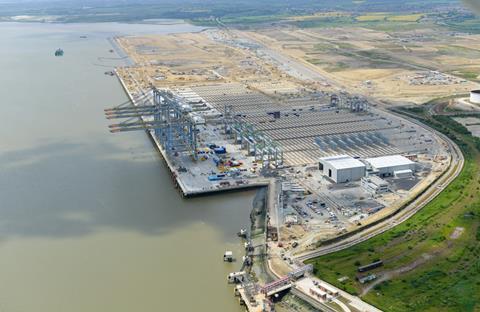
Building a major new seaport is not the simplest of undertakings. Even leaving aside the eye-watering investment required – Dubai-based port specialist DP World is ploughing a staggering £1.5 billion into London Gateway – it takes years of planning negotiation, relocation of wildlife, access to existing and new road infrastructure, a willing local population and a supportive national government for such a project to get off the ground.
Construction at London Gateway (LG), situated at Stanford-le-Hope in Essex, is now in full swing, with an official opening slated for the fourth quarter of 2013, and a phased upscaling planned for the coming years. It doesn’t claim to be the world’s biggest port, with its eventual capacity of 3.5 million containers per year dwarfed by global leader Shanghai’s 30m and even the 13m handled by Dubai and Rotterdam, but it does argue a case to be the best, both in facilities andservice levels.
Certainly the figures deserve respect. The port has been built to handle ships in excess of the largest currently available in the world, the newest 18,000 teu Maersk vessels, features six berths and 24 cranes along an eventual 2.7km quay wall and boasts an almost fully automatic crane stacking system that canoperate 24 hours a day in any weather conditions.
There will be facilities for cold storage, general distribution, light manufacturing, and in fact anything that the user demands, with a particular focus on the reefer trade. Crucially, port bosses are particularly keen to attract fresh food operators, playing on the argument that its proximity to market will significantly boost shelf life.
The site will also feature, at nine million square feet, Europe’s largest logistics park, including a space referred to as a Common User Facility that will allow smaller companies to trade with a view to establishing their own building in the future.
Location is the big selling point for LG, with an enviable position just 22 miles from central London, making it closer than all but Tilbury, though cargo supply chain commercial manager Peter Ward says that its main competition for deep sea container traffic is likely to be Felixtowe.
Rail is a crucial plank in the onwards logistics strategy, with 35 per cent of goods set to depart using that method. As with all other aspects of the site, the new railway is impressive in size and technical capability, with nine tracks having been laid capable of handling trains in excess of 750m in length, all serviced by rail-mounted gantry cranes. DP World estimates that the switch to rail will take some 65m HGV miles and 200 trucks off the roadnetwork every year, though a £150m government spend in improvingjunction 30 of the M25 is making sure the road haulage side of things iscovered too.
LG is already in dialogue with the 16 or so major shippers who supply the UK and expects high sign up, adding that the port is also holding discussions with all the major retailers about leasing space at the port. The biggest deal announced so far is a £200m investment from Marks & Spencer, which will be putting up a 900,000 sq ft distribution centre that will form the third huge DC operated by the retailer under CEO Marc Bolland’s new supply chain strategy.
M&S is expected to focus on clothes and general merchandise rather than food, but LG sees huge potential for the grocery trade. “The fresh produce market is one we are particularly interested in,” says Ward. “We are in a number of discussions with the food sector. As the world shrinks more commodities that were locally produced are now sourced globally. People want year-round produce.”
So why should fresh produce operators consider using LG? “Each individual owner will have their own business case, but generally speaking the benefits are the geographical location and lower land-side transport costs,” explains Ward. “If LG is closer to market that will make your supply chain shorter. We are bringing the port closer to the points of consumption. That’s a big part of our value proposition.”
The British port industry has been somewhat beaten up in recent years, with the diminishing trade at Sheerness and the collapse of the Liverpool Produce Terminal. Yet if LG can deliver on its promise of a world-class venue on the capital’s doorstep, London could once again claim its place as one of the most significant seatrade stopping points on the global map.
Certainly DP World is confident the market is there. “We’ve identified quite a shortage of good-quality food distribution facilities in the south east,” says Ward. “A number of fresh produce ports have declined, with about 80,000 pallet positions not having been replaced.”
The fresh produce trade will want to know that inspections are handled in a way that reduces some of the frustrations sometimes associated with ports, and to that end Ward stresses LG is in dialogue with the government, as well as industry bodies such as the Fresh Produce Consortium.
LG also insists the cost for importers will be comparable to Felixstowe, and while it seems likely there will be a premium for those leasing land-side facilities, Ward believes this will be more than offset by the substantial savings in onward haulage costs, which he estimates at as much as £300-£500 per container.
The site will be opened in phases, with berth 1 coming on line before Christmas, berth 2 next year and berth 3 in 2015. Berths 4 to 6 will open depending on demand. It all shapes up to a mind-boggling project, but with the cash and commitment to make it happen, there is little doubt the landscape of UK seafreight is changing forever.



